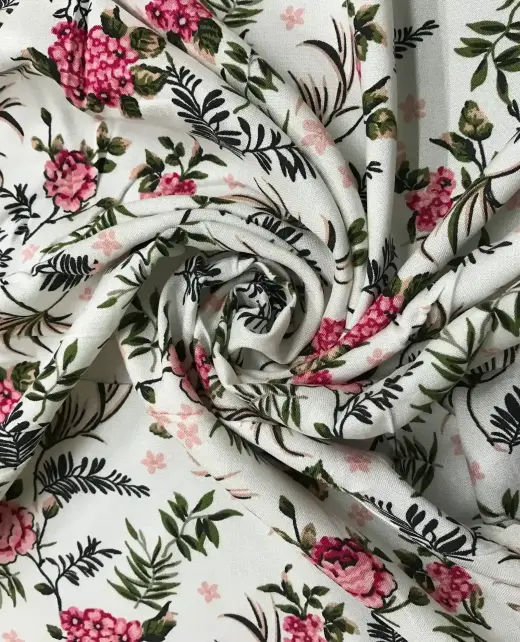Cotton:

What is cotton fabric made of?
Cotton fabric is made from the fibers of the cotton plant. These fibers are spun into yarns and
then woven or knit into fabric.
Why is cotton a popular fabric choice?
Cotton is popular because it is breathable, soft, absorbent, and comfortable to wear. It’s also
versatile and can be used for a wide range of clothing and home textiles.
How durable are prints on cotton fabric?
Prints on cotton are generally durable, especially when properly cared for. Washing in cold water
and avoiding harsh detergents can help maintain the vibrancy of prints.
Does cotton fabric fade over time?
Cotton can experience some fading over time, especially with frequent washing and exposure to
sunlight. However, high-quality prints and dyes tend to resist fading better.
Dobby:
What is dobby fabric?
What are common uses for dobby fabric?
Dobby fabric is often used for dress shirts, blouses, curtains, and decorative textiles due to its
unique patterns and textures.
Are dobby fabric prints long-lasting?
Dobby fabrics can have long-lasting prints, but care is essential. Gentle washing and avoiding
abrasive detergents can help preserve the integrity of prints on dobby fabrics.
How does dobby fabric handle color bleeding?
Dobby fabrics are generally colorfast, meaning they resist color bleeding. However, it’s advisable
to wash them separately initially to prevent any potential colour bleeding.

Jacquard:

What is Jacquard fabric?
Jacquard fabric is woven on a special loom that allows intricate patterns and designs to be woven
directly into the fabric. It can create complex and detailed designs.
What are examples of Jacquard fabric?
Jacquard fabric is commonly used for upholstery, drapery, tapestries, and high-end clothing due
to its intricate designs and luxurious appearance.
Do Jacquard fabrics maintain print durability through wear and tear?
Jacquard fabrics are known for their durability, and prints woven into the fabric tend to hold up
well over time. Proper care, such as gentle washing, enhances their longevity.
How does Jacquard respond to color fading?
Jacquard fabrics can resist color fading due to their intricate weaving process. Still, minimizing
exposure to direct sunlight and using mild detergents can help maintain vibrant colors.
Schiffly:
What is Schiffly embroidery?
Schiffly embroidery is a type of machine embroidery that creates lace-like designs on fabric using
a Schiffli embroidery machine. It often features floral or geometric patterns.
Where is Schiffly embroidery commonly used?
Schiffly embroidery is often used in fashion apparel such as dresses, blouses, and skirts, as well as
in home textiles like curtains and tablecloths to add a decorative touch.
Is Schiffly embroidery prone to fraying or damage?
Schiffly embroidery can be delicate, and excessive friction or rough handling may lead to fraying.
It's advisable to handle garments with Schiffly embroidery with care.
How does Schiffly embroidery endure multiple washes?
Schiffly embroidery can withstand regular washing, but using a gentle cycle and avoiding harsh
chemicals is recommended to preserve both the fabric and the embroidery.

Hakoba:

What is Hakoba fabric?
Hakoba fabric is a type of embroidered or woven cotton fabric originating from India. It features
intricate eyelet patterns and often has a delicate and airy appearance.
What are the traditional uses of Hakoba fabric?
Hakoba fabric is traditionally used for Indian ethnic wear such as sarees, salwar kameez, and
dupattas, as well as for crafting lightweight summer clothing and accessories.
How does Hakoba fabric maintain its embroidery after washing?
Hakoba fabric with embroidery is generally durable, but handwashing or using a gentle cycle is
recommended to prevent any damage to the delicate embroidery.
Does Hakoba fabric retain its color through multiple washes?
With proper care, Hakoba fabric can retain its color through multiple washes. Using mild
detergents and avoiding prolonged exposure to direct sunlight can help.
Viscose:
What is viscose fabric made from?
Viscose fabric is made from regenerated cellulose fibers derived from natural sources such as
wood pulp or bamboo. It is often referred to as a semi-synthetic fabric.
What are the characteristics of viscose fabric?
Viscose fabric is soft, smooth, and has a silky appearance. It drapes well and is breathable, making
it suitable for clothing items like dresses, blouses, and scarves.
Are prints on viscose fabric prone to fading?
Viscose prints may experience some fading over time, especially with frequent washing. However,
using cold water and mild detergents can help preserve the colors.
How does viscose fabric handle color bleeding?
Viscose fabric can be susceptible to color bleeding, especially in the first few washes. Washing
separately and using a color-catching sheet can mitigate this risk.

Polyester:

What is polyester fabric made of?
Polyester fabric is made from synthetic fibers derived from petroleum-based products. It is known
for its durability, wrinkle resistance, and ability to retain color well.
What are common uses for polyester fabric?
Polyester fabric is used in a wide range of applications including clothing, upholstery, bedding,
and outdoor gear due to its strength, versatility, and affordability.
Are prints on polyester fabric resistant to fading?
Polyester is known for its color retention, and prints on polyester fabric are generally resistant to
fading. This makes it a durable choice for long-lasting vibrant colors.
How does polyester endure frequent washing?
Polyester fabric withstands frequent washing well, and prints remain durable. Using a gentle cycle
and avoiding excessive heat in the dryer can further extend the lifespan of prints.